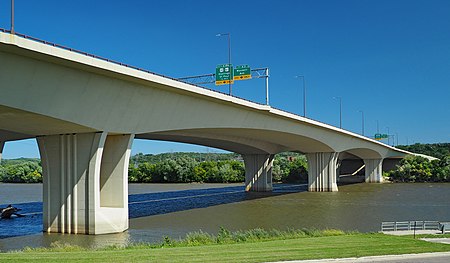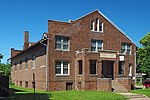Wakota Bridge
Bridges completed in 1959Bridges completed in 2006Bridges completed in 2010Bridges on the Interstate Highway SystemBridges over the Mississippi River ... and 8 more
Buildings and structures in Dakota County, MinnesotaConcrete bridges in the United StatesGreat River RoadInterstate 494Road bridges in MinnesotaTied arch bridges in the United StatesTransportation buildings and structures in Washington County, MinnesotaTransportation in Dakota County, Minnesota

The Wakota Bridge is a ten-lane bridge carrying Interstate 494 over the Mississippi River between South St. Paul and Newport, Minnesota, United States. It was completed in 2010, replacing a four-lane span built in 1959. The name was given to the previous span in the early 1960s, and is derived from the two counties it connects, Washington and Dakota. Lunda Construction Company won the bid to build a new five-lane west-bound span, remove the existing bridge, and build a new five-lane east-bound span, which was completed in 2010. It is the widest bridge in Minnesota in number of lanes, along with the I-35W Saint Anthony Falls Bridge in Minneapolis.
Excerpt from the Wikipedia article Wakota Bridge (License: CC BY-SA 3.0, Authors, Images).Wakota Bridge
Wakota Bridge,
Geographical coordinates (GPS) Address External links Nearby Places Show on map
Geographical coordinates (GPS)
| Latitude | Longitude |
|---|---|
| N 44.883055555556 ° | E -93.015 ° |
Address
Wakota Bridge
Wakota Bridge
55055
Minnesota, United States
Open on Google Maps







